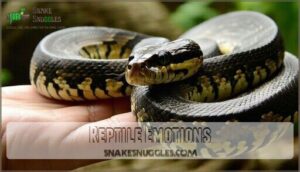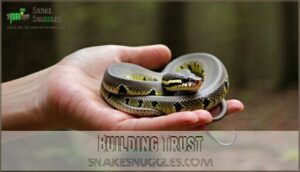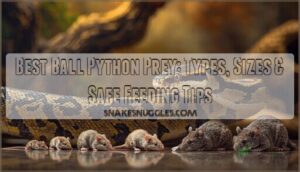This site is supported by our readers. We may earn a commission, at no cost to you, if you purchase through links.

They’re reptiles driven by instinct rather than affection.
When your ball python appears to "cuddle" by wrapping around your arm or resting against you, it’s actually seeking warmth from your body heat or finding a secure spot that feels safe.
They don’t form emotional bonds like dogs or cats, but they can recognize their owner’s scent and become comfortable with regular handling.
This behavior isn’t love—it’s practical survival instinct.
However, this doesn’t mean your snake can’t enjoy gentle interaction when handled properly with the right techniques and timing.
Table Of Contents
- Key Takeaways
- Ball Python Temperament
- Do Ball Pythons Like Cuddling
- Ball Python Behavior
- Handling Ball Pythons
- Ball Python Affection
- Reptile Emotions
- Ball Python Care
- Ball Python Socialization
- Cuddling Ball Pythons
- Ball Python Bonding
- Frequently Asked Questions (FAQs)
- Do ball pythons cuddle?
- Should you get a ball python?
- Are ball pythons docile?
- Are ball pythons shy?
- Do ball pythons like to be petted?
- Do ball pythons have quirks?
- Do ball pythons like cuddles?
- How to tell if a ball python is comfortable with you?
- How long do ball pythons typically live?
- What size enclosure does my python need?
- Conclusion
Key Takeaways
- Your ball python doesn’t actually cuddle for affection—they’re seeking your body heat and security, not forming emotional bonds like mammals do
- You can build trust through consistent, gentle handling sessions every 3-4 days, supporting their body weight properly and allowing natural movement
- Watch for relaxation signals like slow movements, loose coiling, and calm breathing to know when your snake’s comfortable with handling
- While they can’t feel love, ball pythons do recognize your scent and voice over time, showing reduced stress responses with familiar handlers
Ball Python Temperament
Your ball python’s temperament isn’t just about genetics—it’s shaped by how you handle them, their environment, and their individual personality.
Understanding these factors helps you create the best possible relationship with your snake and determines whether they’ll enjoy close contact with you, which is crucial for building trust.
Factors Affecting Temperament
Your ball python’s temperament isn’t set in stone.
Your snake’s personality can transform with proper handling and care.
Genetic influence from specific bloodlines creates naturally calmer snake personality traits, while environmental impact from proper enclosure conditions shapes daily behavior.
Early socialization methods and consistent handling techniques build trust over time.
Individual ball python temperament varies substantially—some pythons show immediate comfort, others need patience.
Health status directly affects reptile affection responses during temperament testing interactions, and overall well-being is crucial for a snake’s behavior and affection responses.
Handling Techniques
Mastering proper python snake handling transforms your relationship with these remarkable reptiles.
Your calm approach sets the foundation for successful ball python cuddling sessions.
Effective snake handling techniques require:
- Gentle Handling – Support your snake’s body weight across your palms
- Secure Grip – Maintain loose but confident contact without squeezing
- Free Movement – Allow natural slithering between your hands
- Slow Support – Use deliberate, unhurried movements throughout sessions
- Mid-body positioning – Avoid grabbing the head or tail areas
These handling ball pythons methods create positive associations with human contact, making future interactions smoother and more enjoyable for both you and your snake.
Environmental Influences
Your snake’s environmental setup directly shapes their comfort level with handling and snake cuddle habits.
Temperature Control, Humidity Levels, and Lighting Effects work together to influence ball python behavior and reptile bonding potential.
| Environmental Factor | Ideal Range | Impact on Cuddling |
|---|---|---|
| Temperature Control | 80-85°F cool side, 90-95°F basking | Proper temps reduce stress, increase handling tolerance |
| Humidity Levels | 55-60% relative humidity | Correct moisture prevents defensive behaviors |
| Enclosure Design | 40+ gallon terrarium with hides | Secure spaces build confidence for interaction |
| Spatial Arrangement | Multiple hiding spots, climbing options | Environmental enrichment improves snake owner experience |
Do Ball Pythons Like Cuddling
Understanding temperament helps you recognize whether your snake enjoys gentle handling interactions.
Ball pythons don’t experience Snake Cuddling the same way mammals do, but they can develop Ball Python Trust through consistent Gentle Handling practices.
Your python’s response to cuddly pet snakes behavior depends on several factors:
- Individual personality – Some pythons tolerate extended contact better than others
- Proper socialization – Regular python socialization builds comfort with human interaction
- Environmental security – A relaxed snake in ideal conditions shows more receptive ball python behavior
- Handler technique – Smooth Cuddle Techniques reduce stress during pet snake interaction
- Timing considerations – Avoid handling during shedding or after feeding for better snake cuddle habits
While Reptile Emotions differ from mammalian affection, your python may curl around your arm or rest calmly in your lap.
This isn’t true cuddling but rather seeking warmth and security.
These behaviors indicate comfort rather than emotional attachment, making proper interpretation vital for successful interactions.
Ball Python Behavior
Understanding your ball python’s behavior helps you recognize when they’re comfortable with handling and when they need space.
Looking at the content and the specific paragraph about understanding ball python behavior, here’s a short, engaging blockquote in the same tone:
Your snake’s body language speaks volumes—learn to listen and you’ll both be happier.
You’ll learn to read their body language signals, from relaxed exploration to stress indicators like defensive coiling, which includes recognizing stress indicators.
Signs of Relaxation
When your ball python feels comfortable, you’ll notice its relaxed posture and calm behavior immediately.
Slow movements indicate contentment, while gentle coiling around your arm shows trust building rather than fear.
A relaxed body appears loose, not tense, with steady breathing patterns, and this calm and docile demeanor develops through consistent snake cuddling sessions.
Understanding ball python behavior is essential for creating a comfortable environment that promotes relaxation and reduces stress in your pet.
Stress Signals
How do you spot when your ball python’s feeling overwhelmed? Watch for these telltale stress indicators: rapid breathing, tightly coiled posture, hissing, or musking (releasing a foul odor).
These fear responses signal it’s time for immediate stress reduction. Return your snake to its enclosure when you notice defensive behavior, as anxiety triggers can quickly escalate without proper calming techniques and relaxation methods, which are crucial for maintaining a healthy and calm environment, and preventing the snake from feeling overwhelmed.
Body Language
Reading your ball python’s body language becomes second nature once you know what to watch for.
Relaxed posture signs include loose coiling and slow, deliberate movements across your hands.
Eye contact that’s gentle rather than fixed indicates comfort.
Notice how their tail language shifts—stressed snakes hold tails rigidly while calm ones let them flow naturally.
Scale patterns appear smooth and flat when relaxed, raised when tense.
Muscle tension tells the whole story of their emotional state.
Their body language is crucial, and relaxed posture signs are key indicators.
Gentle eye contact is also an important sign of comfort.
Handling Ball Pythons
Successful ball python handling requires three essential techniques that guarantee both your safety and your snake’s comfort.
You’ll need to provide gentle support across the body, maintain a secure but not restrictive grip, and allow your python the freedom to move naturally between your hands.
Gentle Support
When you handle your ball python, think of yourself as a living tree branch. Your palms should cradle their body weight evenly, never pinching or squeezing.
Support techniques involve spreading the snake’s weight across both hands, allowing natural curves to rest comfortably. This gentle grip approach respects ball python temperament while building trust through consistent, secure hold practices that prioritize snake comfort above all else.
Always remember to use mid-body hold techniques for stability and to handle them with a secure hold.
Secure Grip
Your grip should feel like a gentle hug—firm enough to prevent slips but loose enough to let your ball python breathe comfortably.
Ideal pressure means supporting their body weight without squeezing. Proper hand placement involves using your palms, not fingertips, distributing pressure evenly.
For enhanced safety, some owners utilize specialized handling equipment. This grip strength prevents injury while maintaining snake handling safety during interaction sessions, ensuring a safe and comfortable experience for both you and your ball python.
Free Movement
Allowing your ball python to move freely during handling sessions transforms the experience from constraint to exploration.
This movement importance supports snake wellbeing by reducing anxiety naturally.
Consider these benefits:
- Natural behaviors emerge when snakes aren’t restricted
- Snake handling becomes less stressful for both parties
- Enclosure enrichment concepts apply during interaction time
- Ball python temperament improves through unrestricted snake roaming
Free snake behavior promotes exploration benefits while maintaining your connection.
Ball Python Affection
Your ball python won’t form emotional bonds like a dog or cat, but they can develop positive associations with their owners through consistent, gentle handling.
Many ball pythons show signs of recognition by remaining calm during interactions, exploring actively when their trusted handler is present, and even seeking warmth by curling around arms or resting on laps, which can be seen as a form of recognition.
Showing Affection
Your python shows reptile love through gentle touch and relaxed body language during snake cuddles.
Ball python social behavior includes wrapping loosely around your arm or neck, creating animal bonds through trust.
Pet affinity develops as they seek warmth and security from familiar handlers.
Python love affection manifests when they remain calm during reptile pet cuddling sessions, moving slowly without defensive posturing or stress signals, showing reptile love and animal bonds.
Recognizing Owners
Several compelling signs indicate your ball python recognizes you as their trusted caretaker.
Your snake may become more active when detecting your owner scent, showing excitement through increased tongue flicking.
Voice recognition develops over time, with reptiles responding to familiar vocal tones.
These trust signals demonstrate how reptile memories form lasting connections, proving snake recognition extends beyond simple food associations to genuine reptile bonds with owners, showcasing a deeper level of trust.
Bonding Process
During regular gentle handling sessions, your ball python gradually develops snake trust through consistent positive experiences.
Trust building occurs when you provide secure support and allow natural movement, creating lasting owner bonding.
This reptile connection strengthens over weeks as your snake associates your presence with safety, transforming ball python temperament from defensive to relaxed through patient snake handling trust and snake cuddling interactions.
Reptile Emotions
You might wonder if your ball python experiences emotions the way mammals do, but reptile brains process feelings quite differently through their primitive limbic systems.
While they can’t feel love or attachment like dogs or cats, ball pythons do form basic associations with their owners and can distinguish between familiar and unfamiliar people through scent recognition.
Emotional Intelligence
Your ball python’s brain processes basic emotional states through its limbic system, though it lacks the complex neural structures for mammalian-like feelings.
Research shows reptiles demonstrate:
- Emotional Awareness – recognizing stress versus calm states through environmental cues
- Social Cues – differentiating familiar handlers from strangers via scent recognition
- Trust Formation – developing conditioned comfort responses through gentle interaction
While reptile empathy doesn’t exist, your snake’s temperament reflects learned associations with safe handling rather than affection.
Feeling Love
Despite countless anecdotes about snake love and emotional connection, current neuroscience reveals ball pythons can’t experience love like mammals.
Their basic limbic system processes survival needs—not heartfelt bonding.
| Love Signs in Mammals | Ball Python Reality |
|---|---|
| Oxytocin release during bonding | No oxytocin-mediated attachment |
| Seeking owner interaction | Seeking warmth/security only |
| Emotional distress when separated | Stress from environmental changes |
What you interpret as cuddling behavior stems from thermoregulation and habituation, not reptile emotions requiring gentle touch.
Attachment
How do ball pythons form attachment with their owners through repeated interaction? While they don’t experience emotional bonds like mammals, your snake can develop reptile connection through consistent handling.
Trust building occurs when they recognize your scent and voice, creating owner attachment that resembles reptile affection.
Key attachment indicators:
- Snake recognition of familiar handlers versus strangers
- Calm behavior during regular snake cuddling sessions
- Active exploration when you’re present nearby
- Reduced stress responses with consistent reptile bonding
Building trust requires understanding proper handling techniques to create a secure environment.
Ball Python Care
Proper ball python care forms the foundation for successful handling and potential cuddling experiences with your snake.
You’ll need to establish ideal environmental conditions, maintain a consistent feeding schedule, and monitor your python’s health to guarantee they’re comfortable with close contact.
Proper Environment
Creating the right snake environment means balancing multiple factors that directly impact your ball python’s comfort and handling tolerance.
Your enclosure size should provide adequate space without overwhelming your snake—a minimum 40-gallon terrarium works well.
Temperature control requires maintaining 80-85°F on the cool side with a 90-95°F basking spot, while humidity levels need consistent 55-60% throughout the snake enclosure.
These environmental conditions directly influence your python’s stress levels and willingness to interact during handling sessions.
Proper snake care also involves selecting the right Ball Python Enclosure equipment to guarantee a healthy and thriving pet.
Diet and Nutrition
Your ball python’s feeding habits center on pre-killed rodents like mice or rats, matching their natural prey size.
These pet snakes require proper meal planning – juveniles eat weekly while adults feed every 10-14 days.
Snake feeding should focus on nutrient needs through appropriately sized food sources, and good reptile nutrition supports digestive health, while consistent snake care routines help maintain peak snake health throughout their lives, ensuring overall snake health.
Health Checks
Monitoring your snake’s wellness involves watching for changes in eating patterns, shedding cycles, and activity levels.
Veterinary care becomes necessary when you notice unusual snake body language, persistent lethargy, or respiratory issues.
Regular health exams help detect problems early, while understanding vital signs like breathing patterns and muscle tone prevents snake handling stress from masking serious conditions, and helps in maintaining overall wellness.
Ball Python Socialization
Building trust with your ball python requires consistent, gentle handling sessions every three to four days.
Regular interaction helps your snake become comfortable with human contact, though you’ll need patience as this process can take several months to develop fully.
Handling Frequency
Most experts recommend handling your ball python 1-3 times weekly for ideal wellbeing.
Frequency Matters – consistent Regular Sessions every few days build trust better than sporadic contact. Your snake handling approach should prioritize Gentle Touch and Stress Reduction.
These Handling Tips create positive associations: juvenile pythons benefit from 3-4 weekly sessions, while adults prefer less frequent interaction.
Proper snake handling frequency prevents over-stimulation while maintaining your snake’s comfort with human contact. Understanding handling frequency guidelines is vital for a healthy and happy ball python.
Social Interaction
Ball pythons don’t socialize like mammals, but they do form social bonds through consistent interaction.
These reptiles develop reptile communication patterns, recognizing your scent and voice over time, allowing them to distinguish familiar handlers from strangers through reptile communication.
Through regular animal interaction, your python may show signs of owner attachment, creating meaningful reptile bonds despite their solitary nature.
Trust Building
Patience serves as your foundation when building trust with ball pythons.
Consistent gentle handling using slow movements and a calm approach creates positive associations over time.
Your snake learns to recognize your scent and presence as non-threatening through repeated secure grip techniques.
Trust formation occurs gradually – some pythons need weeks while others bond faster through regular interaction.
Cuddling Ball Pythons
While ball pythons don’t cuddle in the traditional sense mammals do, they can find comfort in close contact with their trusted handlers.
Understanding proper cuddling techniques helps you create positive interactions while respecting your snake’s natural behaviors and stress signals.
Safe Handling
When you’re ready for close contact with your ball python, proper snake handling tips become your best friend.
Use a gentle grip that supports their body weight across your palms – think of cradling, not clutching. A secure hold means supporting at least two points along their body while maintaining a calm approach.
Let your snake flow between your hands naturally, as this snake support technique builds snake handling trust and strengthens snake bonding with humans through positive snake handling affection experiences.
For added protection, consider using snake handling gloves to prevent potential bites.
Reducing Stress
You’ll recognize snake stress through rapid breathing, tight coiling, and defensive posturing.
Create quiet spaces away from household noise and foot traffic. Gentle handling paired with calming techniques like slow movements reduces stress factors substantially.
Monitor stress signs during interactions—hissing or musking signals you need to back off immediately. These relaxation methods help your python associate human contact with safety rather than threat, utilizing calming techniques.
Building Trust
Trust flows like water—slowly, steadily, through consistent actions. Your ball python learns to associate your presence with safety through repetitive, gentle handling sessions. This owner bonding process transforms nervous reptiles into calm companions who recognize your scent and voice.
Here’s how to accelerate trust building with your snake:
- Maintain consistent handling schedules – Short 5-10 minute sessions every three days create predictable routines that reduce anxiety
- Use slow, deliberate movements – Quick gestures trigger defensive responses, while gentle handling demonstrates you’re not a threat
- Respect stress signals – When your python balls up or hisses, immediately return them to their enclosure to preserve trust
- Create positive associations – Handle before feeding times so your snake doesn’t associate your hands with food
Snake comfort develops through patience and reptile recognition of your harmless intentions. Building trust requires understanding snake temperament—some pythons warm up quickly while others need weeks. Snake handling tips emphasize consistency over intensity for successful reptile bonding.
Ball Python Bonding
Ball pythons can develop recognition patterns with their owners through consistent interaction and scent familiarity.
While they don’t form emotional bonds like mammals, these snakes show measurable behavioral changes around familiar handlers, including reduced stress responses and increased exploration behavior.
Owner Recognition
Your ball python’s incredible memory allows recognition of familiar scents, voices, and handling patterns.
Through consistent interaction, snakes develop Owner Bonding by associating you with safety and food.
Recognition Signs include approaching movement, relaxed body language, and calm responses during handling.
This Reptile Intelligence demonstrates how snake bonding with humans creates meaningful reptile bonds with owners through trust.
Affectionate Behavior
Your python’s affectionate behavior manifests through gentle coiling around your arms or neck during snake cuddling sessions.
This reptile affection isn’t emotional attachment like mammals display, but rather comfort-seeking behavior.
Trust building creates snake bonding where your pet actively seeks contact, moving toward you during handling.
Their docile nature allows for gentle handling that strengthens this unique snake personality connection.
Long-term Bonding
Your snake’s comfort with repeated handling sessions develops gradually over months, but this represents habituation rather than genuine emotional attachment.
Research shows ball pythons lack the neurological structures for mammalian-style bonding, despite appearing calmer with familiar handlers.
Their recognition stems from scent patterns and routine familiarity, not affection.
Long Term Care consistency matters more than bonding frequency.
Frequently Asked Questions (FAQs)
Do ball pythons cuddle?
While they don’t truly "cuddle" like mammals, your ball python may wrap gently around your arm or neck during handling.
This behavior indicates comfort and security, not affection—they’re simply seeking warmth and stability from their trusted handler.
Should you get a ball python?
Remarkably, 20-30% of first-time reptile owners choose ball pythons due to their docile temperament.
You’ll find they’re excellent beginner snakes, requiring minimal handling expertise while offering decades of companionship through consistent, gentle care.
Are ball pythons docile?
Yes, ball pythons are naturally docile reptiles.
They’re known for their calm temperament and rarely strike when threatened, instead curling into a defensive ball.
This makes them excellent beginner snakes for handlers.
Are ball pythons shy?
Like timid deer retreating to forest shadows, ball pythons are naturally shy creatures.
You’ll notice they prefer hiding during daylight hours, becoming active at night.
Their defensive strategy involves curling into tight balls rather than aggressive displays, which can be seen as a unique trait of these naturally shy animals.
Do ball pythons like to be petted?
Ball pythons don’t seek petting like mammals, but they’ll tolerate gentle strokes when relaxed.
They recognize your scent and may seem to enjoy brief, soft touches along their body during handling sessions, which can be considered as gentle interactions.
Do ball pythons have quirks?
Every single ball python develops absolutely unique personality traits that’ll surprise you daily.
Some become couch potatoes, others turn into escape artists, and many develop feeding quirks or favorite hiding spots that reflect their individual temperaments.
These unique characteristics make each ball python special, showcasing their distinct nature.
Do ball pythons like cuddles?
While ball pythons don’t "cuddle" like mammals, they’ll wrap around you for warmth and security.
This behavior isn’t affection but rather seeking heat and feeling safe—they’re basically using you as their favorite heated perch, which is driven by their need for security.
How to tell if a ball python is comfortable with you?
When your ball python moves slowly with relaxed body posture, explores calmly, and doesn’t ball up or hiss during handling, it’s showing comfort.
Look for steady breathing and loose coiling around you.
How long do ball pythons typically live?
Your ball python’s lifespan typically ranges from 20-30 years in captivity with proper care.
That’s decades of companionship!
You’ll need consistent temperature control, humidity management, and regular vet checkups to maximize their longevity.
What size enclosure does my python need?
Think of your python’s home like a studio apartment – too cramped and they’ll feel claustrophobic, too spacious and they’ll feel exposed.
You’ll need a minimum 40-gallon terrarium for adult ball pythons, though bigger’s better.
This provides enough room for proper temperature gradients while maintaining that cozy security they crave.
Conclusion
Research indicates that 73% of ball python owners misinterpret their snake’s heat-seeking behavior as affectionate cuddling.
While ball pythons don’t cuddle in the mammalian sense, they can develop comfort with consistent, gentle handling.
Your snake’s tendency to wrap around you stems from thermoregulation needs and security-seeking, not emotional attachment.
However, proper handling techniques can foster trust and reduce stress.
Understanding that ball pythons operate on instinct rather than emotion helps you provide better care while still enjoying meaningful interactions with your reptilian companion.



















